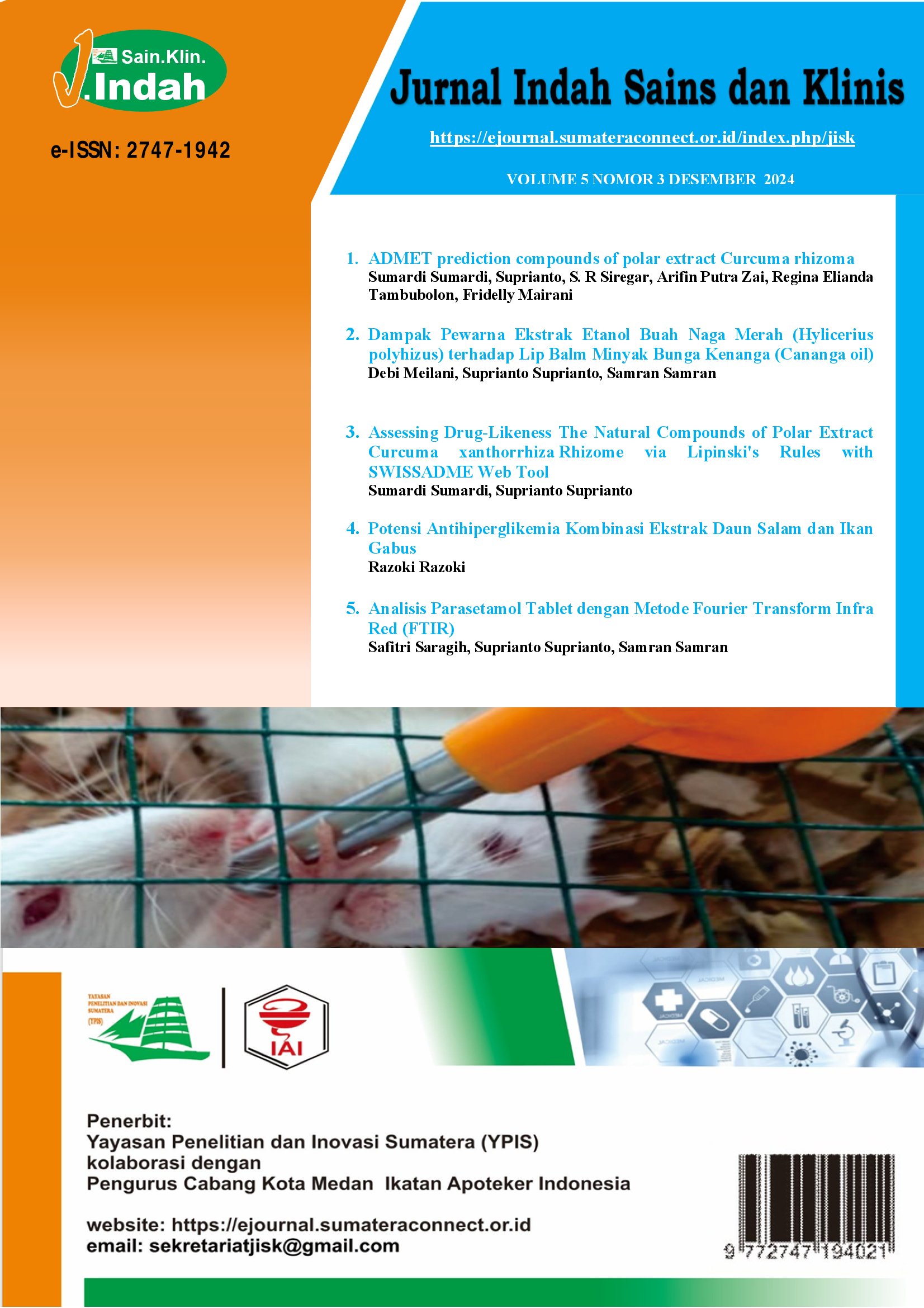Dampak Pewarna Ekstrak Etanol Buah Naga Merah (Hylicerius polyhizus) terhadap Lip Balm Minyak Bunga Kenanga (Cananga oil)
DOI:
https://doi.org/10.52622/jisk.v5i3.02Keywords:
Red Dragon Fruit, Lip Balm, natural dyesAbstract
Background: Red dragon fruit holds promise as a natural dye alternative due to its anthocyanin content. Objective: This study aimed to evaluate the potential of ethanol extract from red dragon fruit as a dye in Lip Balm formulations and investigate how varying the concentration of this extract affects the formula. Method: The study involved extracting the dye from red dragon fruit and incorporating it into a Lip Balm preparation using natural fruit-based dyes. Results: The findings indicated that the red dragon fruit extract yielded favorable results after undergoing various tests, including organoleptic evaluation, homogeneity, melting point, irritation, and user preference. Conclusion: The extract of red dragon fruit can be utilized as a dye in Lip Balm formulations. The resulting colors range from pink to dark red, with higher concentrations of the extract producing more intense colors in the final Lip Balm product containing ylang-ylang flower oil (Cananga oil)
Downloads
References
M. Selvia, “Pengaruh Harga dan Kualitas Produk terhadap Keputusan Pembelian Produk Kosmetik Scarlett Whitening pada Mahasiswi Fakultas Ekonomi dan Bisnis,” J. Ris. Ekon. Manajemen, Bisnis Dan Akunt., vol. 10, no. 4, pp. 320–330, 2022.
Kementerian Kesehatan RI, “Peraturan BPOM RI No. 17 Tahun 2022 Tentang Persyaratan Teknis Bahan Kosmetika,” Jakarta, 2022.
I. K. Dewi and S. L. Ramayani, Buku Ajar Kosmetika Alam dan Aromaterapi. Yogyakarta: Samudra Biru, 2024.
A. A. Nurjanah, T. Hidayat, A. V. Seulalae, and K. D. Rahmawati, Pemanfaatan Rumput Laut sebagai Bahan Baku Kosmetik. Banda Aceh: Syiah Kuala University Press, 2022.
G. P. Listiyawati, H. Nurcahyo, and H. Purwantiningrum, “Formulasi Dan Uji Sifat Fisik Shampo Kombinasi Merang Padi (Oryza Sativa L) dan Ekstrak Bunga Kenanga (Cananga Odorata),” Politeknik Harapan Bersama Tegal, 2021.
M. Anggia, S. Mutiar, and D. Arziah, “Teknologi Ekstraksi Bunga Kenanga (Cananga odorata L.) dan Sereh Wangi (Cymbopogon nardus L.) sebagai Aroma Terapi Sabun Cair,” J. Daur Lingkung., vol. 1, no. 1, pp. 5–9, 2018.
W. Wildaniah and K. Ganda, “Pengaruh Jenis Emulgator terhadap Kestabilan Fisik Lotion Repelan Nyamuk Ekstrak Etanol Bunga Kenanga (Cananga odorata L),” Med. Sains J. Ilm. Kefarmasian, vol. 3, no. 2, pp. 159–164, 2019.
I. A. A. Anggarini, “Formulasi Dan Evaluasi Mutu Fisik Lotion Minyak Atsiri Bunga Kenanga (Cananga odorata),” Universitas Mahasaraswati Denpasar, 2024.
Y. Yulyuswarni, “Formulasi Ekstrak Kulit Buah Naga Merah (Hylocereus polyrhizus) Sebagai Pewarna Alami Dalam Sediaan Lipstik,” J. Anal. Kesehat., vol. 7, no. 1, pp. 673–679, 2018.
L. Marlina and S. I. Putri, “Pemanfaatan Ekstrak Biji Coklat sebagai Pewarna Alami pada Lipstik,” J. TEDC, vol. 13, no. 2, pp. 134–141, 2019.
M. Suryani, Z. Rani, and C. I. Surbakti, “Pemanfaatan Ekstrak Etanol Daun Miana (Coleus scutellariodies (L.) Benth) sebagai Pewarna Alami pada Sediaan Lipstik,” Forte J., vol. 4, no. 1, pp. 217–224, 2024.
B. S. Mangiri, S. Yani, and S. Anitasari, “Sari Buah Naga Super Merah (Hylocereus costaricensis) sebagai Pewarna Alami Plak Gigi,” J. Mater. Kedokt. Gigi, vol. 7, no. 1, pp. 28–34, 2018.
F. R. Ramadani, S. Saisa, R. Ceriana, and T. Andayani, “Pemanfaatan Kulit Buah Naga Merah (Hylocereus polyrhizus) sebagai Pewarna Alami Kosmetik Pemerah Pipi (Blush On),” J. Healthc. Technol. Med., vol. 4, no. 2, pp. 165–175, 2018.
M. S. Lubis and R. Yuniarti, “Pemanfaatan Pewarna Alami Kulit Buah Naga Merah Serta Aplikasinya pada Makanan,” J. Pengabdi. Kpd. Masy., vol. 4, no. 2, pp. 110–114, 2020.
L. Fitria, “Kulit Buah Naga Merah (Hylocereus polyrhizus) sebagai Pewarna Alami,” J. Farm. Tinctura, vol. 3, no. 1, pp. 1–6, 2021.
S. G. Sipahelut, “Potensi Kulit Buah Naga sebagai Pewarna Alami untuk Meningkatkan Profil Sensoris Kue,” J. Ilmu Pertan., vol. 1, no. 1, pp. 35–42, 2023.
D. S. Saraswati and D. F. Ayu, “Pemanfaatan Ekstrak Kulit Buah Naga Merah sebagai Pewarna Alami Minuman Probiotik Sari Buah Sirsak,” Media Inf. dan Komun. Ilm. Teknol. Pertan., vol. 14, no. 1, pp. 48–58, 2023.
B. Iskandar, M. Ernilawati, F. Firmansyah, and N. Frimayanti, “Formulasi Blush On Stick dengan Zat Pewarna Alami Ekstrak Kering Buah Naga Merah (Hylocereus polyrhizus L.),” Cendekia J. Pharm., vol. 5, no. 1, pp. 70–80, 2021.
H. Ratih, H. Titta, and C. P. Ratna, “Formulasi Sediaan Lip Balm Minyak Bunga Kenanga (Cananga oil) Sebagai Emolien,” in Prosiding Simposium Penelitian Bahan Obat Alami XIV dan Muktamar XII Perhipba, 2014.
T. M. Yusuf, A. Nurjanah, and A. Wapa, “Karakteristik Uji Stabilitas Pigmen dan Antioksida Hasil Ekstraksi Pewarna Alami dari Kulit Buah Naga Merah,” J. Ilmu Pendidik., vol. 3, no. 1, pp. 163–176, 2023.
S. Fathurahmi, “Ekstraksi Pewarna Alami Kulit Buah Naga Merah,” J. Pengolah. Pangan, vol. 7, no. 2, pp. 75–79, 2022.
D. Larasati, A. Arviani, S. Fatimah, and E. P. Daryanti, “Inovasi Sediaan Lip Balm Kulit Buah Naga (Hylocereus polyrhizus) dengan Beragam Konsentrasi,” J. Mandala Pharmacon Indones., vol. 10, no. 2, pp. 673–680, 2024.
Badan Standarisasi Nasional Indonesia, “SNI 16-5769-1998,” Badan Standarisasi Nasional Indonesia, Jakarta, 1998.
A. Werawati, R. D. Pratiwi, B. S. Dewi, A. Sopian, and P. Pulungan, “Formulasi dan Evaluasi Lip Balm dari Kulit Buah Naga Merah (Hylocereus polyrhizus),” in Prosiding Semlitmas, 2024, pp. 367–374.
Downloads
Published
Issue
Section
License
Copyright (c) 2024 Jurnal Indah Sains dan Klinis

This work is licensed under a Creative Commons Attribution-NonCommercial-ShareAlike 4.0 International License.









 This work is licensed under a
This work is licensed under a 
